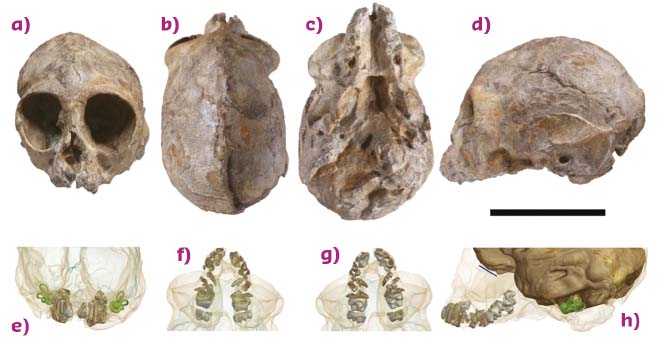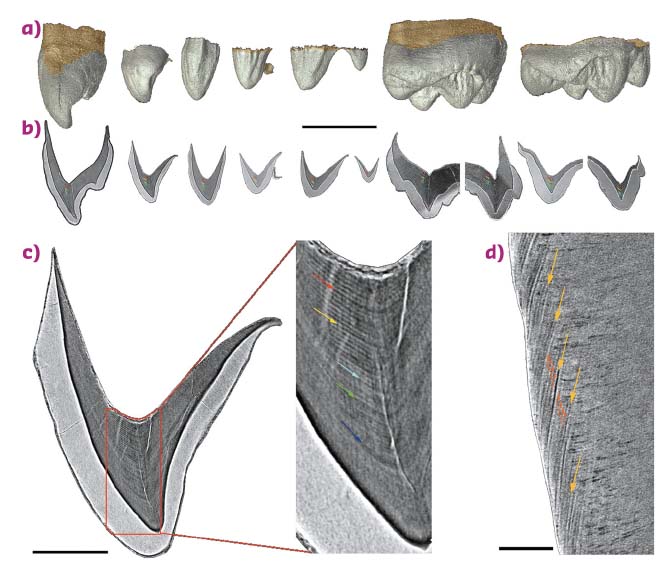- Home
- Users & Science
- Scientific Documentation
- ESRF Highlights
- ESRF Highlights 2017
- Structure of materials
- New infant ape skull from kenya sheds new light on ape evolution
New infant ape skull from kenya sheds new light on ape evolution
The newly discovered most complete ape skull yet known from Napudet, Kenya, KNM-NP 59050, is dated to 13 million years. Remarkable preservation of the fossil coupled with synchrotron scanning made it possible to visualise both the external and internal morphology of the skull. The skull belongs to a new species, Nyanzapithecus alesi, a member of a now-extinct lineage close to the origin of the common ancestor of apes and humans.
Among living primates, humans share the same lineage with the apes, including chimpanzees, gorillas, orangutans and gibbons, and are grouped together in the superfamily Hominoidea. Our common ancestor with chimpanzees lived in Africa six to seven million years ago and many spectacular fossil finds have revealed how humans evolved since then. In contrast, the fossil record of common ancestors of living apes and humans before 10 million years ago is poor, making it difficult to find answers to two fundamental evolutionary questions: Did the common ancestor of living apes and humans originate in Africa, and, what did these early ancestors look like?
 |
|
Fig. 132: KNM-NP 59050. Specimen as preserved in a) anterior view, b) superior view, c) inferior view, and d) left lateral view. e-h) 3D visualisations based on X-ray microtomography, in views matching a-d, and with the bone rendered transparent to show the deciduous dental roots (beige), the unerupted permanent tooth crowns (grey), the bony labyrinths (green) and the endocast (blue transparent in (e-g) and beige in (h); the olfactory fossa marked by the blue line placed directly underneath). Scale bar 5 cm. |
KNM-NP 59050 is a new cranium of an infant ape from the 13 million-year-old Middle Miocene site of Napudet in the Turkana Basin in Kenya [1]. KNM-NP 59050 is unique in that nearly all elements of external and internal morphology are preserved in a single extinct ape specimen. Many of the most informative parts are preserved inside the fossil and, to make these visible, it was scanned at ID19 using propagation phase contrast X-ray synchrotron microtomography (PPC-SR-μCT; Figures 132e-h) [2]. Aspects of the internal morphology available for study include the unerupted teeth, the inner ears housing the organs of hearing and balance, the middle ear (including ossicles on both sides), the nasal cavity and paranasal sinuses, and the brain endocast.
 |
|
Fig. 133: Virtual histological slices of KNM-NP 59050. a) 3D rendering of the right unerupted permanent teeth germs. b) Virtual histological slices of teeth with coloured arrows showing the stress lines in dentine used for developmental cross-correlations of all the teeth and cusps. Scale bar is 5 mm. c) Detail of the Andresen lines in the dentine, and reference stress lines in the right I2 germ. Scale bar is 1 mm. d) Details of the enamel microstructure of this tooth, showing four daily lines (dark orange arrows) between consecutives Retzius lines (light orange arrows), indicating a long period line periodicity of five days. Scale bar is 100 µm. |
The quality of images of the unerupted adult teeth with their daily growth record lines were so fine that it could be established from the teeth that the infant was about one year and four months old at death (Figure 133). The volume of the brain cavity, estimated to be about 101 ml, slightly smaller than that of gibbons at the same stage of dental development, is significantly larger than the 35 ml estimates for adult monkey specimens of equivalent geological age. The lemon-sized skull, with its notably small snout, looks most like a baby gibbon. However, analyses show that this appearance is not exclusively found in gibbons, and evolved multiple times among extinct apes, monkeys, and their relatives. It was also established, based on the morphology of the unerupted adult teeth inside the infant ape’s skull, that the specimen belonged to a new species, Nyanzapithecus alesi. A phylogenetic analysis revealed that Nyanzapithecus alesi belonged to a now-extinct lineage that existed in Africa for over 10 million years and was very close to the origin of humans and apes’ common ancestor.
Principal publication and authors
New infant cranium from the African Miocene sheds light on ape evolution, I. Nengo (a), P. Tafforeau (b), C. Gilbert (c), J. Fleagle (d), E. Miller (e), C. Feibel (f), D. Fox (g), J. Feinberg (g), K. Pugh (c), C. Berruyer (b), S. Mana (h), Z. Engle (g) and F. Spoor (i), Nature 548, 169-174 (2017); doi:10.1038/nature23456.
(a) Department of Anthropology, De Anza College and Turkana Basin Institute, Stony Brook University (USA)
(b) ESRF
(c) Department of Anthropology, Hunter College, CUNY (USA)
(d) Department of Anatomical Sciences, Stony Brook University (USA)
(e) Department of Anthropology. Wake Forest University (USA)
(f) Departments of Anthropology and Earth and Planetary Sciences Rutgers University (USA)
(g) Department of Earth Sciences, University of Minnesota (USA)
(h) Department of Geological Sciences, Salem State University (USA)
(i) Department of Cell and Developmental Biology, UCL (UK) and Department of Human Evolution Max Planck Institute (Germany)
References
[1]. I. Nengo et al., Nature 548, 169 (2017).
[2]. P. Tafforeau et al., Appl. Phys. A-Mater. 83, 195 (2006).



